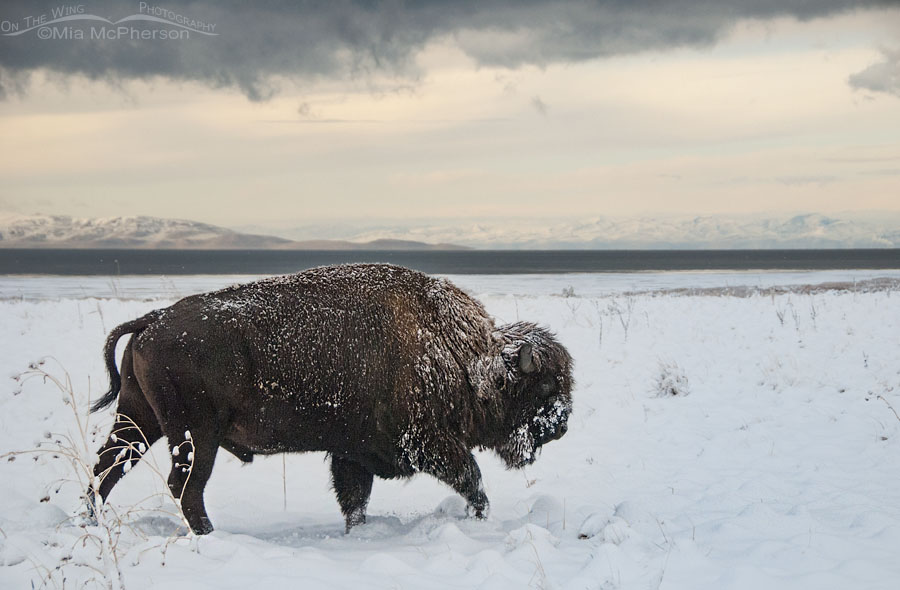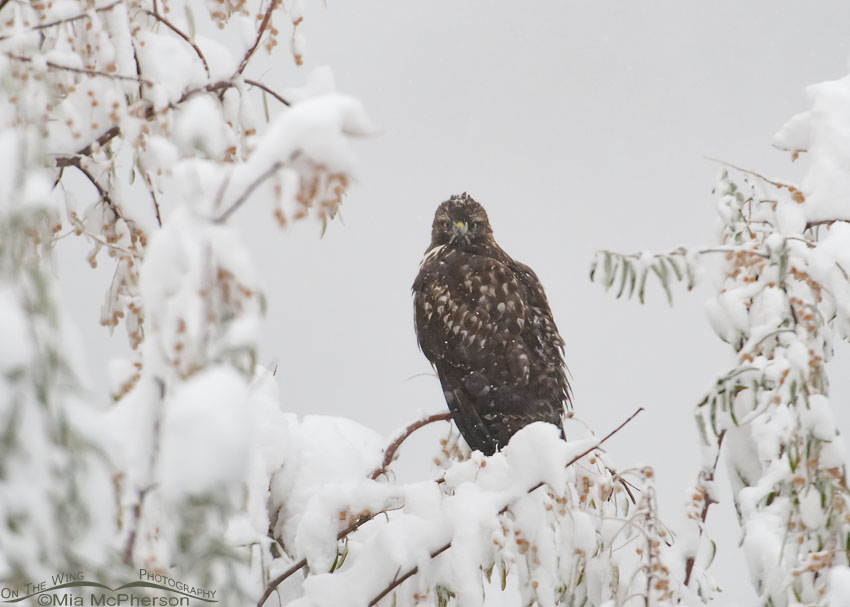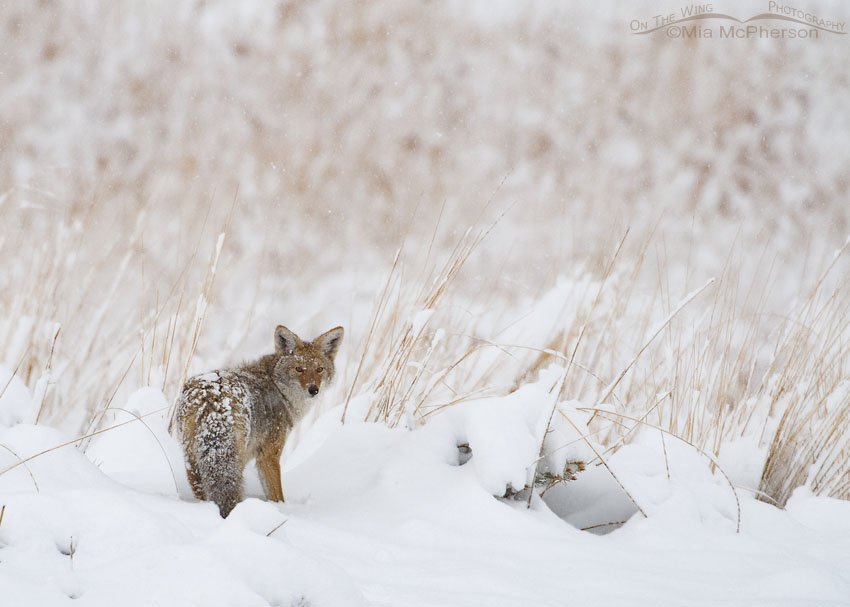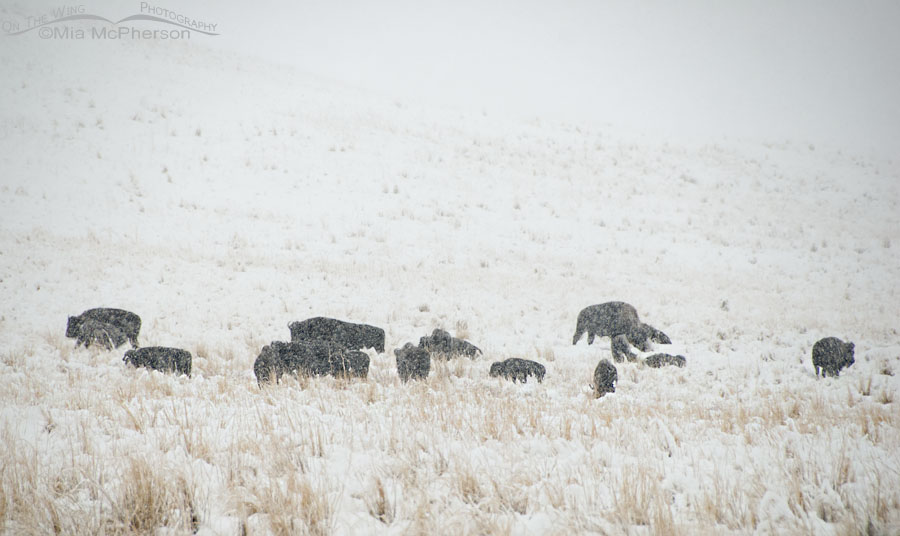 Snow-covered American Bison trudging through snow – Nikon D200, f5.6, 1/1000, ISO 400, +1.0 EV, Nikkor 18-200mm VR at 65mm, natural light
Snow-covered American Bison trudging through snow – Nikon D200, f5.6, 1/1000, ISO 400, +1.0 EV, Nikkor 18-200mm VR at 65mm, natural light
In 2012 we had snow in October and by the time the 10th of November rolled around we had had plenty of the snow in the Salt Lake Valley and a snow storm rolled through that day. On the 9th of November I scraped a foot of snow off of my Jeep and on the morning of the 10th I had to scrape more off just to be able to back out of the drive way. Even though there were gray skies and a heavy snow falling that morning saw me headed to Antelope Island State Park to see if I could find birds and beasts to photograph in a blizzard. There weren’t many other people on the island and in some places there was virgin snow to drive through. With the windows down it was silent except for the tires crunching through the thick blanket of white stuff on the ground.
I saw American Bison fighting in a snow storm that morning and other bison had a shield of snow around their muzzles where they had pushed their noses through the snow to get to the grasses buried beneath it. There was a break in the clouds to the west when I photographed this bison bull and I could actually see the Great Salt Lake and snow-covered mountains in the distance.
 Red-tailed Hawk in a November blizzard – Nikon D300, f6.3, 1/2000, ISO 1600, +1.3 EV, Nikkor 200-400mm VR at 400mm, natural light, not baited
Red-tailed Hawk in a November blizzard – Nikon D300, f6.3, 1/2000, ISO 1600, +1.3 EV, Nikkor 200-400mm VR at 400mm, natural light, not baited
The break in the clouds was just a small sucker hole because the rest of the morning I didn’t see any more sunlight break through them.
I did find a disgruntled looking immature Red-tailed Hawk towards the south end of the island perched in some of the Russian Olive trees. It isn’t a great photo by any means but I took it because I wanted to show the harsh conditions the birds and beasts have to survive in during winter in the Great Basin. It is hard to see the falling snow in this photo because there was a fog behind the hawk but you can see flakes of snow in front of the young raptors plumage.
 Coyote hunting in a November snow storm – Nikon D300, f6.3, 1/1600, ISO 1600, +2.0 EV, Nikkor 200-400mm VR at 400mm, natural light
Coyote hunting in a November snow storm – Nikon D300, f6.3, 1/1600, ISO 1600, +2.0 EV, Nikkor 200-400mm VR at 400mm, natural light
Spotting a Coyote hunting is always fun and it can be even more fun when photographing them during a blizzard. This Coyote had a snow-covered back, face and tail when I photographed it while it hunted for prey in the tall grasses and when it stopped and looked towards me I had to take this photo. I remember thinking that I wished I had a thick coat of fur while I sat with the window down and the bitter cold air making me shiver while I photographed the Coyote.
 American Bison herd in a November blizzard – Nikon D200, f5.6, 1/640, ISO 400, +2.3 EV, Nikkor 18-200mm VR at 200mm, natural light
American Bison herd in a November blizzard – Nikon D200, f5.6, 1/640, ISO 400, +2.3 EV, Nikkor 18-200mm VR at 200mm, natural light
On the south end of the island I had to stop and photograph a small herd of American Bison as the snow fell heavily on them. Winter can be hard on them but the bison are tough and they manage to get through until the warmth of spring causes new spring growth.
As I sit here this morning writing this I think about how in the past few years how the snow doesn’t start falling in the valley until the end of November or even in December. Sure there is snow up in the high country already but the snow down here seems to fall later and later each year. For some that might be cause to celebrate but for me it reminds me that we are already seeing the effects of climate change. There is overwhelming evidence and scientific proof that we are having hotter summers, less rain, later snows, worsened wildfire seasons, crazy weather patterns, lowered levels in the Great Salt Lake and less water running through the rivers that feed it. Today I wonder what will it be like five years from now.
The birds and beasts on Antelope can survive the harsh winters here but as each years passes I wonder how they will be able to adapt to our changing climate. I can’t help but be concerned not just for the birds and beasts on the island but every living being on the planet.
Sorry to be a downer today.
Mia


What gorgeous images! Bison, coyotes, and of course, redtails are some of my favorite critters. I especially love the redtail stink eye you were gifted for that photo!
As for your conclusions, I’m right there with you, feeling powerless to turn this tide. Decades ago, scientists warned us on how the climate change would affect us, and darn if those chickens haven’t come home to roost. The expansion of sheer stupidity is stunning and downright frightening.
Snowy images from Novembers past portend climate change, I agree.
As does having to mow the lawn again yesterday. Yes, it’s a downer!
Beautiful images! As a winter loving/snow loving individual, I share your concerns. I honestly don’t know why we humans are now such sissies when it comes to the cold and snow. We have the knowledge and technology to adapt to such conditions if we so choose. There are very few days when I don’t venture outside.
I share your fears. And revel in these beautiful scenes.
Your concerns are ours Mia. It does seem like the snows fall later along the Wasatch Front but usually Thanksgiving is when the snow usually starts to fall in the valleys. It seems the mulberry tree in our last house kept it’s leaves a bit longer before they fell in a pile all at once and the hummingbirds seem to be staying a wee bit longer as well. It’s ashamed we humans are responsible for altering the very earth that gives us life. You’re not a downer Mia, just a realist. By the way, your images truly capture the American West and the beautiful state of Utah.
Your photos are beautiful. Your commdnts and conclsion is scary….and common sense, never mind scientific…just open your eyes and mind….and observe and THINK!!!
Your final question Mia is VERY relevant to all of us! Many think that technology developments will allow us to adapt. However the birds and beasts don’t have that possibility.
Such beautiful images, Mia!